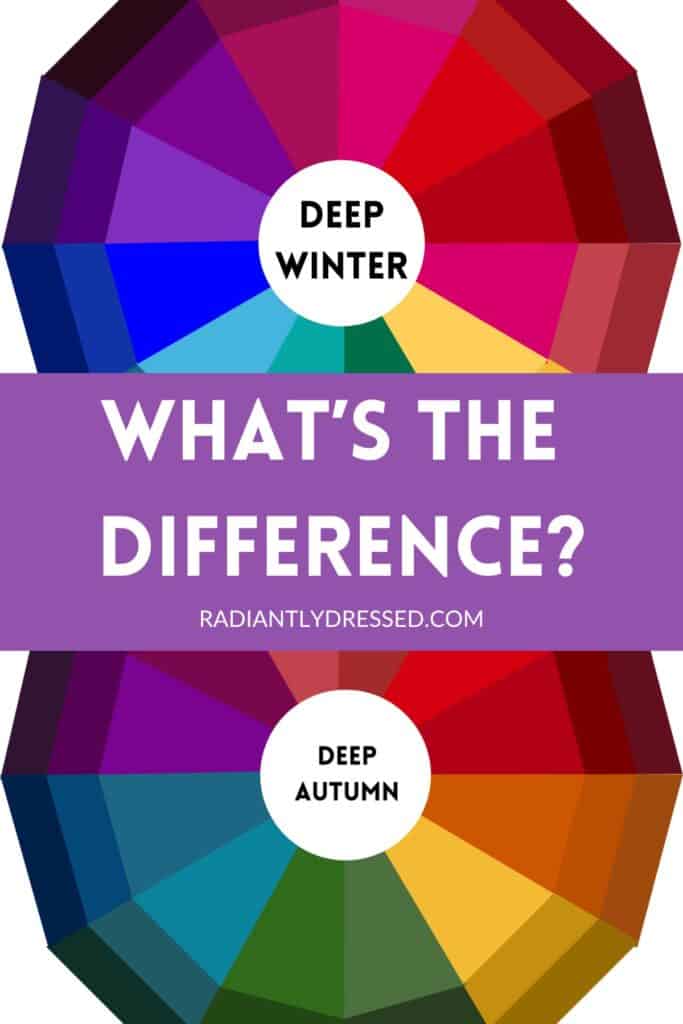Deep Winter vs Deep Autumn is all about understanding your unique undertones, contrast levels, and which colors enhance your natural beauty.

Are you color confused, overwhelmed by color analysis and the specifics that go into it? I am super excited to start a brand new series, digging into some of the attributes of the seasons and exploring some of the more difficult ones to nail down.
This is intended to be a deeper comparison exploration of the tonal element of seasonal analysis, in which I will examine more closely the variants of deep, soft, light, bright, cool, and warm, and offer tips to distinguish between the sisters in each of these tonal designations.
I’m starting with the deep seasons for one core reason: volume. In North America, deep autumn and deep winter are two of the most common seasons that we find. Each comprises about 10-12%, making these two seasons account for nearly a quarter of the overall population.
With this distribution, it’s not at all confusing why these two seasons present the most confusion. That’s simply a lot of people caught between these two.
Deep Winter is characterized by the cool and dark palette of the winter season with a hint of depth and richness borrowed from autumn. If your skin, eyes, or hair have a deep, almost magnetic hue, you might find that the cool, bold colors of Deep Winter celebrate your features. The colors from this palette are high in contrast and intensity, often presenting a sophisticated and elegant vibe.
Deep Autumn, on the other hand, brings forth a warmth that distinguishes it from its winter counterpart. Warm, rich, and muted tones define this palette, reflecting the cozy and earthy aspects of late autumn. Your natural coloring is likely to have a golden quality if Deep Autumn is your season, with colors that evoke the feeling of an abundant harvest and crisp October evenings. Embracing this palette means playing up the depth in your coloring with shades that reflect a warm glow.
Table of Contents
Understanding Color Seasons
When exploring color seasons, you’re delving into a system designed to help you identify which colors best complement your natural palette.
Deep Winter and Deep Autumn are two of the twelve color seasons that form part of a Seasonal Color Analysis. This analysis assesses your skin tone, eye, and hair color to categorize you into a specific season. Each season is linked to a set of colors that harmonize with your natural coloration.
Deep Winter characteristics include:
- Undertones: Cool to Neutral-Cool
- Hue: Primarily cool hues with some neutral
- Best Colors: Dark, rich, and saturated
Deep Autumn traits are:
- Undertones: Neutral to Warm
- Hue: Rich Earthy tones with muted brightness
- Best Colors: Medium-to-dark with low-medium contrast
By understanding your color season, you can enhance your wardrobe and makeup choices, ensuring that they flatter your natural coloring. Remember, the best hues for you are those that reflect your inherent tones, creating a harmonious and balanced look.
Characteristics of Deep Winter
The Deep Winter season is marked by a striking and rich color palette. This profile typically combines the icy sharpness of winter with a hint of autumn’s depth and warmth.
Color Palette of Deep Winter
Your Deep Winter palette centers around cool and deep tones, which complement your typically cool and vivid personal coloring. Expect an array of richly saturated hues that balance the coolness of winter with just a touch of warmth to enhance your natural contrast.
- Primary Colors:
- Cool Blues: Navy, Sapphire
- Purples: Deep Plum, Amethyst
- Secondary Colors:
Neutral Shades:
- Black (acts as a staple in your wardrobe)
- Charcoal Grey
- Crisp White (instead of off-white or cream, which are too warm for your palette)
To integrate these colors into your wardrobe, begin with the neutrals as your foundation and intersperse the primary and secondary colors for a balanced, harmonious look that resonates with your Deep Winter characteristics.
Characteristics of Deep Autumn
Deep Autumn is a season that exudes warmth with its rich and earthy tones. The palette is both vibrant and muted, giving you flexible yet distinctive color choices.
Color Palette of Deep Autumn
Your Deep Autumn color palette is inspired by the season’s natural hues, from the fiery oranges of falling leaves to the deep reds of late sunsets. Opt for a combination of the following colors to complement your season,
- Primary Colors:
- Warm Earth Tones: Burnt Orange, Deep Terra Cotta
- Browns: Rich Mahogany, Warm Chocolate
- Secondary Colors:
- Yellows: Mustard, Golden Yellow
- Reds: Rust, Tomato Red
- Neutral Shades:
- Dark Brown (serves as a cornerstone in your wardrobe)
- Olive Green
- Creamy Ivory (instead of stark white, which is too cool for your palette)
Remember, your colors should feel like a natural extension of the autumn landscape, rich and welcoming, without the stark contrast found in the Deep Winter palette.
How to Distinguish Deep Winter vs Deep Autumn
Warm or Cool Undertone
The first aspect we’re diving into is undertones, and to some extent, I’ll touch upon overtones as well. In the realms of Deep Winter and Deep Autumn, one leans more towards cool, and the other towards warm. Deep Winter is the cooler season, while Deep Autumn is the warmer one.
Many people assume they’re neutral and struggle to choose between the two. However, the truth is, everyone’s undertones are either cool or warm. It’s the overtones layered over these undertones that often cause confusion, making us think we’re cool when we’re actually warm, or vice versa.
I’ve got a simple trick to help determine your undertones: the pinch test. Just pinch the end of your finger, as if you were about to give blood, and observe the color it turns. It’ll be a shade of red—either a cool plummy purple or a warm orangey coral. Plummy purple indicates cool undertones, while orangey coral suggests warm ones. If you’re unsure, it’s safer to lean towards warm.
Once you’ve identified your undertone, let’s briefly consider overtones. Deep Winter individuals, with their cool undertones, often have a yellow overtone. Remember basic color mixing from school? Blue and yellow make green, so people with a mix of cool blue undertones and yellow overtones may have an olive complexion, leading them to mistakenly think they’re warm.
On the other hand, Deep Autumn people usually have a warm red undertone paired with a violet overtone, which is more common to Winter. Mixing red and purple results in a cooler purple, potentially misleading them to believe they’re cool because of their overtone, while their undertone remains warm.
By applying this simple test and analysis, you can clarify your undertones, guiding you towards identifying whether you’re more aligned with Deep Winter or Deep Autumn before we delve into further details.
Contrast and Intensity
The next concept crucial in distinguishing Deep Winter from Deep Autumn revolves around chroma, also known as contrast or intensity. While both seasons share a dark value and differ in hue—Deep Winter leaning cool and Deep Autumn warm—their contrast levels also set them apart. Winter seasons are characterized by their brightness, requiring high contrast and vividly saturated colors. On the other hand, Autumn is noted for its more muted tones.
Deep Winter and Deep Autumn find themselves in a unique position, balancing between the extremes of their respective season’s brightness and mutedness. For example, Clear Winter represents the brightest facet of the Winter spectrum, and Soft Autumn, the most muted within the Autumn category.
However, individuals within these seasons will inherently gravitate towards the chroma that best aligns with their season’s profile. Deep Winter individuals are suited to richer, deeper, and more vibrant shades, whereas Deep Autumn requires hues that are softened, often by gray or brown, to dial down the color saturation and intensity slightly.
Consider the color teal, which generally suits both seasons well. Reflect on your preference: do you lean towards a brighter, more vivid jewel-toned teal, or a softer, more subdued shade? Your inclination here is a direct indicator of where you fall on the chroma scale. If you’re drawn to the brighter and more intense hues, you’re aligning with Winter’s traits.
If you prefer the gentler, less contrasting colors, you’re veering towards Autumn’s characteristics. This distinction can help you understand whether your color needs are better met by the brighter, high-contrast approach of Winter or the softer, more muted palette of Autumn.

Winter and Autumn Neutrals
When trying to determine if you’re a Deep Winter or a Deep Autumn, a key factor to consider is how you interact with neutral colors. Deep Winter individuals stand out as those who can effortlessly wear black and white. They thrive on the high contrast these colors provide, often preferring to pair them together for a striking look.
Deep Winters gravitate towards darker hues, finding that medium shades of neutrals don’t complement them as well. For instance, when it comes to gray, Deep Winters usually opt for very dark shades, steering clear of medium grays. They look best in colors that are either significantly dark or lean towards icy, almost white silvers.
Deep Autumns, while also favoring the extreme ends of the value spectrum, cannot embrace optic white—it simply doesn’t suit them. Instead, they shine in ivory, cream, alabaster, or bone, which enhance their warmth without overwhelming it. Black, interestingly, tends to be less problematic for Deep Autumns; it’s dark and deep enough to harmonize with their palette without creating the harsh contrast that white does.
However, black may not be the best criterion for distinguishing between these two seasons due to its versatility for Deep Autumns. Instead, look to those mid-range neutrals like grays and browns. Consider the appeal of gray and tan neutrals that sit comfortably in the middle range of colors. Which resonates more with you, and which looks better on you?
Deep Winters might find it challenging to pull off shades like camel, tan, beige, or khaki. So, if you’re debating between these two seasons and find that these hues don’t flatter you, you’re likely a Deep Winter. On the flip side, if gray tends to wash you out, making you look a bit pallid or unwell, then you’re probably a Deep Autumn.
Exploring how neutrals work with your complexion can be an enlightening way to pinpoint whether you’re more aligned with the Deep Winter or Deep Autumn season.
Color Test: Magenta vs Rust
The most effective method for distinguishing between Deep Winter and Deep Autumn is what I like to call the magenta-rust test. These two colors are key in determining which season suits you better. If you find yourself unsure, I suggest finding fabrics in deep magenta and warm, rich cognac or rust. Drape these fabrics around your face under natural light and take a photo using the back camera of your phone—avoid the selfie mode, as it can distort the results.
Observe the effects of each color on your appearance. For Deep Winters, rust may introduce unwanted yellow overtones to your skin or even give it a slightly greenish cast. It could highlight skin imperfections, deepen the appearance of wrinkles, and generally not flatter you. On the other hand, if you’re an Autumn, magenta can be equally unflattering. It might make your skin look pasty, emphasize blemishes and imperfections more starkly, and make lines and wrinkles appear more pronounced.
This test is centered on understanding how specific colors interact with your skin tone. If you’re torn between identifying as a Deep Winter or Deep Autumn, there’s no need to test with an array of fabrics. Using magenta and rust should efficiently reveal which season enhances your natural coloring, providing a clear direction in your color analysis journey.

Determining Your Color Season
Embarking on the journey to discover your color season is more than just an exercise in aesthetics; it’s about aligning your wardrobe and makeup choices with the natural palette of your hair, eyes, and skin tone. The delineation between Deep Autumn and Deep Winter is crucial, as each carries its own unique set of colors that can either elevate or dull your natural beauty.
DIY Color Analysis
For those keen on exploring their color season from the comfort of their home, my DIY Color Analysis Course is the perfect starting point. This course empowers you with the knowledge to:
Transitioning to Professional Color Analysis
While the DIY course provides a solid foundation, transitioning to a professional color analysis can further refine your understanding of your color season.
A professional analysis offers:
- Expert Guidance: Benefit from an experienced eye that can discern subtleties in your coloring, leading to a more nuanced understanding of your season.
- Customized Palette Recommendations: Receive a personalized palette that includes detailed recommendations for clothing and makeup, ensuring every choice you make is in harmony with your natural beauty.
While there is a cost associated with professional color analysis, the investment is in yourself—yielding a individualized assessment that enhances your style, confidence, and the way you present yourself to the world.
Whether you start with DIY analysis or dive straight into professional consultation, understanding your color season—Deep Autumn or Deep Winter—is a transformative step towards embracing your authentic self and showcasing your inherent beauty with every outfit and makeup choice.
Tired of going round in circles trying to figure out your color season? Hack the same process used by professional color analysts to figure out your season from the comfort of your home, and stop feeling confused about color analysis with Personal Prism.
FAQ
What is the difference between Dark Winter and Autumn and Deep Winter and Autumn?
Interestingly, when it comes to distinguishing between these terms—Dark Winter versus Autumn and Deep Winter versus Autumn—there is no actual difference. The labels “Dark” and “Deep” are often used interchangeably to describe the same color seasons, focusing on the richer, more saturated end of the Winter and Autumn spectrums.
What are the main differences between Deep Autumn and Deep Winter?
The core distinction lies in their undertones and color palettes. Deep Autumn is known for warm undertones and embraces earthy colors like burnt orange and olive green. Deep Winter, on the other hand, is defined by cool undertones, higher contrast, and a preference for crisp blues, icy purples, and stark whites.
Can Deep Autumns wear black?
While black is quintessentially Deep Winter, Deep Autumns are not precluded from wearing black. It can be harmoniously integrated into their wardrobe, especially when paired with warmer accessories or layers to maintain their season’s warmth.
Why do some colors look good on me but don’t seem to fit my season?
Color compatibility can extend beyond the prescribed palettes of your season, reflecting the unique variances in individual complexions. It’s crucial to prioritize confidence and personal affinity for colors, sometimes even stepping outside your season’s guidelines to embrace what truly resonates with you.
What if I can wear both rust and magenta well? Does that mean I’m neutral?
Successfully wearing both rust and magenta could suggest a more neutral undertone, but the key lies in which color more significantly enhances your natural beauty. Usually, one will provide a clearer complexion boost, indicating a closer alignment with either Deep Autumn or Deep Winter.
Is it necessary to stick strictly to my color season’s palette?
While your color season offers a guide to optimize your natural beauty, personal style and expression hold value. Experimenting with and incorporating colors outside your designated palette is a personal choice that can add depth and personality to your wardrobe.
How does knowing my color season benefit me?
Recognizing your color season simplifies wardrobe decisions, ensuring that your clothing choices consistently flatter your natural appearance. This knowledge not only boosts confidence but also streamlines shopping, aiding in the creation of a cohesive and versatile wardrobe.
Can my color season change over time?
While your skin’s undertone and the foundation of your color season remain constant, factors such as changes in hair color, lifestyle shifts, or evolving personal preferences can influence how you engage with your color season, possibly leading you to adapt your palette accordingly.
Final Thoughts on Deep Winter vs Deep Autumn
As we wrap up our dive into the vibrant worlds of Deep Winter and Deep Autumn, I’ve armed you with the tools to discover your true color season. By dissecting your undertones to pinpoint whether you’re cooler or warmer, assessing your personal contrast and intensity, to identifying the neutrals that elevate your look, we’ve covered substantial ground.
And let’s not forget the magenta-rust test—your secret weapon in the quest to uncover whether Deep Winter’s cool vibrance or Deep Autumn’s warm richness is your color sanctuary.
This exploration aimed to demystify the nuances that set Deep Winter and Deep Autumn apart, despite their shared affinity for the darker, more profound color spectrum. Armed with this knowledge, I hope you’re now poised to confidently claim your season.
Whether it’s the striking contrast of Deep Winter or the earthy depth of Deep Autumn that calls to you, step into your colors with confidence. Here’s to rocking your season’s palette with flair and making every outfit a testament to your newfound color savvy.
Related Color Analysis Articles:
- Best Online Color Analysis Tools
- How to Discover Your Signature Color
- Decluttering Your Clothes Using Color

Navigating the nuances between Dark Winter and Dark Autumn involves a deep dive into your personal coloring.
Stacey is the owner and creator behind Radiantly Dressed. She is a certified image consultant and AICI member focusing on creating simplicity in wardrobes via color and style.













